Showing Spotlights 2201 - 2208 of 2783 in category All (newest first):
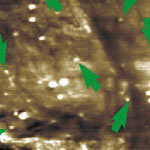 Nanomaterial-based drug-delivery and nanotoxicology are two of the areas that require sophisticated methods and techniques for characterizing, testing and imaging nanoparticulate matter inside the body. Especially the potential risk factors of certain nanomaterials have become a heated topic of discussion recently. Most, if not all, toxicological studies on nanoparticles rely on current methods, practices and terminology as gained and applied in the analysis of micro- and ultrafine particles and mineral fibers. The development of novel imaging techniques that can visualize local populations of nanoparticles at nanometer resolution within the structures of cells - without destroying or damaging the cell - are therefore important. Researchers in the U.S. have now demonstrated that at ultrasonic frequencies, intracellular nanomaterial cause sufficient wave scattering that a probe outside the cell can respond to. This ultrasonic holography technique provides a non-invasive way of looking inside a cell.
Nanomaterial-based drug-delivery and nanotoxicology are two of the areas that require sophisticated methods and techniques for characterizing, testing and imaging nanoparticulate matter inside the body. Especially the potential risk factors of certain nanomaterials have become a heated topic of discussion recently. Most, if not all, toxicological studies on nanoparticles rely on current methods, practices and terminology as gained and applied in the analysis of micro- and ultrafine particles and mineral fibers. The development of novel imaging techniques that can visualize local populations of nanoparticles at nanometer resolution within the structures of cells - without destroying or damaging the cell - are therefore important. Researchers in the U.S. have now demonstrated that at ultrasonic frequencies, intracellular nanomaterial cause sufficient wave scattering that a probe outside the cell can respond to. This ultrasonic holography technique provides a non-invasive way of looking inside a cell.
Jun 23rd, 2008
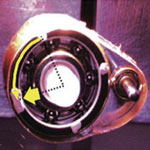 A fast-growing body of nanotechnology research is dedicated to nanoscale motors and molecular machinery. The results of these studies are spectacular: well-designed molecules or supramolecules show various movements upon exposure to various stimuli, such as molecular shuttles, molecular elevators and molecular motors. So far, however, nobody has been able to directly observe the movements of these molecular machines and utilize the mechanical work done by them. Now, an international group of researchers have succeeded in amplifying the minuscule change in structures at a molecular level caused by an external stimulus (light) to a macroscopic change through a cooperative effect of liquid crystals. Using liquid-crystalline elastomers (LCEs) ? unique materials having both properties of liquid crystals (LCs) and elastomers ? the scientists have successfully developed new photomechanical devices, including the first light-driven plastic motor. In other words, with this novel material the energy from light can be directly converted into mechanical work without the aid of batteries, electric wires, or gears.
A fast-growing body of nanotechnology research is dedicated to nanoscale motors and molecular machinery. The results of these studies are spectacular: well-designed molecules or supramolecules show various movements upon exposure to various stimuli, such as molecular shuttles, molecular elevators and molecular motors. So far, however, nobody has been able to directly observe the movements of these molecular machines and utilize the mechanical work done by them. Now, an international group of researchers have succeeded in amplifying the minuscule change in structures at a molecular level caused by an external stimulus (light) to a macroscopic change through a cooperative effect of liquid crystals. Using liquid-crystalline elastomers (LCEs) ? unique materials having both properties of liquid crystals (LCs) and elastomers ? the scientists have successfully developed new photomechanical devices, including the first light-driven plastic motor. In other words, with this novel material the energy from light can be directly converted into mechanical work without the aid of batteries, electric wires, or gears.
Jun 20th, 2008
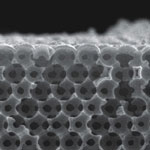 One of the true nanotechnologies that pre-dates the explosion of the popular use of the word during the past few years is Atomic Layer Deposition (ALD). This gas phase chemical process is used to create extremely thin coatings only a few nanometers thick which can be deposited in a precisely controlled way. Initially used as a technique for making a specific type of light display (electroluminescent display) smaller and more efficient, the ALD process was invented and patented by Tuomo Suntola and his co-workers in Finland in 1974 (co-incidentally, this is the year that the term 'nanotechnology' was first defined by Norio Taniguchi). The fundamental notion behind Atomic Layer Deposition is rather simple: It is a process by which an atomic layer of material can be affixed to a surface material one layer at a time. By depositing one layer per cycle, ALD offers extreme precision in ultra-thin film growth since the number of cycles determines the number of atomic layers and therefore the precise thickness of deposited film.
One of the true nanotechnologies that pre-dates the explosion of the popular use of the word during the past few years is Atomic Layer Deposition (ALD). This gas phase chemical process is used to create extremely thin coatings only a few nanometers thick which can be deposited in a precisely controlled way. Initially used as a technique for making a specific type of light display (electroluminescent display) smaller and more efficient, the ALD process was invented and patented by Tuomo Suntola and his co-workers in Finland in 1974 (co-incidentally, this is the year that the term 'nanotechnology' was first defined by Norio Taniguchi). The fundamental notion behind Atomic Layer Deposition is rather simple: It is a process by which an atomic layer of material can be affixed to a surface material one layer at a time. By depositing one layer per cycle, ALD offers extreme precision in ultra-thin film growth since the number of cycles determines the number of atomic layers and therefore the precise thickness of deposited film.
Jun 19th, 2008
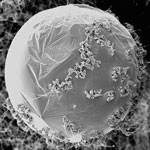 Storing the fuel that is needed to run a hydrogen car in a compact and affordable way is still a major challenge. You would need about 5 kg of hydrogen to have the same average driving range as today's cars. Since hydrogen's density is only 1/10th of a gram per liter at room temperature, that means you somehow need to pack 50,000 liters of hydrogen into your tank. There are three ways of doing this: as a high-pressure compressed gas; a cryogenic liquid; or as a solid. Rather than using hundreds of atmospheres to compress hydrogen into a tank, or cooling it down to minus 252 C to liquefy it, hydrogen storage in solid form offers the safest alternative for transportation and storage of hydrogen. Research in this area has led to metal hydrides, chemical hydrides, and physisorption-based storage, where hydrogen is adsorbed onto the interior surfaces of a porous material. The stored hydrogen can then be released by heat, electricity, or chemical reaction. Many metals are capable of absorbing hydrogen as well. The storage of gas in solids is not only an intriguing alternative for hydrogen storage but other types of gases, such as carbon dioxide and other environmentally important gases as well. Gas storage in solids is quickly becoming an important technology, with applications ranging from energy and the environment to biology and medicine. A new review article describes the types of material that make good porous gas storage materials, why different porous solids are good for the storage of different gases, and what criteria need to be met to make a useable gas storage material.
Storing the fuel that is needed to run a hydrogen car in a compact and affordable way is still a major challenge. You would need about 5 kg of hydrogen to have the same average driving range as today's cars. Since hydrogen's density is only 1/10th of a gram per liter at room temperature, that means you somehow need to pack 50,000 liters of hydrogen into your tank. There are three ways of doing this: as a high-pressure compressed gas; a cryogenic liquid; or as a solid. Rather than using hundreds of atmospheres to compress hydrogen into a tank, or cooling it down to minus 252 C to liquefy it, hydrogen storage in solid form offers the safest alternative for transportation and storage of hydrogen. Research in this area has led to metal hydrides, chemical hydrides, and physisorption-based storage, where hydrogen is adsorbed onto the interior surfaces of a porous material. The stored hydrogen can then be released by heat, electricity, or chemical reaction. Many metals are capable of absorbing hydrogen as well. The storage of gas in solids is not only an intriguing alternative for hydrogen storage but other types of gases, such as carbon dioxide and other environmentally important gases as well. Gas storage in solids is quickly becoming an important technology, with applications ranging from energy and the environment to biology and medicine. A new review article describes the types of material that make good porous gas storage materials, why different porous solids are good for the storage of different gases, and what criteria need to be met to make a useable gas storage material.
Jun 18th, 2008
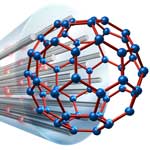 Optical imaging of materials is full with rich physical, chemical and biological information about the sample, because the optical energies in the visible range coincide with the atomic and molecular transition energies of many materials. Apart from the topographical information, the optical image therefore contains information about intrinsic properties of a material. However, the wave nature of light prevents the light to focus in a volume smaller than half of the wavelength, which is about 200-300 nm for visible light. Therefore, it is almost impossible to image nanomaterials, which could be a few nanometers in size, using optical imaging process. A typical lens made of, for example glass, will not be sufficient to image a nanomaterial. In work that gives rise to a new concept of a lens for optical imaging, scientists in Japan have proposed a lens made of silver nanorods, rather than a curved glass surface. This metallic nanolens is capable of manipulating light in such a way that an optical image of nanoscale objects can be obtained in the visible range.
Optical imaging of materials is full with rich physical, chemical and biological information about the sample, because the optical energies in the visible range coincide with the atomic and molecular transition energies of many materials. Apart from the topographical information, the optical image therefore contains information about intrinsic properties of a material. However, the wave nature of light prevents the light to focus in a volume smaller than half of the wavelength, which is about 200-300 nm for visible light. Therefore, it is almost impossible to image nanomaterials, which could be a few nanometers in size, using optical imaging process. A typical lens made of, for example glass, will not be sufficient to image a nanomaterial. In work that gives rise to a new concept of a lens for optical imaging, scientists in Japan have proposed a lens made of silver nanorods, rather than a curved glass surface. This metallic nanolens is capable of manipulating light in such a way that an optical image of nanoscale objects can be obtained in the visible range.
Jun 17th, 2008
 You might have seen our news item from a few days ago about BMW's shape shifting concept car. NASA has worked on something much more revolutionary, called the 'Morphing' program, for a few years already. The idea is that aircraft of the future will not be built of traditional, multiple, mechanically connected parts and systems. Instead, aircraft wing construction will employ fully-integrated, nanotechnology enabled embedded 'smart' materials and actuators that will enable aircraft wings with unprecedented levels of aerodynamic efficiencies and aircraft control. Able to respond to the constantly varying conditions of flight, sensors will act like the nerves in a bird's wing and will measure the pressure over the entire surface of the wing. The response to these measurements will direct actuators, which will function like the bird's wing muscles. Just as a bird instinctively uses different feathers on its wings to control its flight, the actuators will change the shape of the aircraft's wings to continually optimize flying conditions. Active flow control effectors will help mitigate adverse aircraft motions when turbulent air conditions are encountered.
You might have seen our news item from a few days ago about BMW's shape shifting concept car. NASA has worked on something much more revolutionary, called the 'Morphing' program, for a few years already. The idea is that aircraft of the future will not be built of traditional, multiple, mechanically connected parts and systems. Instead, aircraft wing construction will employ fully-integrated, nanotechnology enabled embedded 'smart' materials and actuators that will enable aircraft wings with unprecedented levels of aerodynamic efficiencies and aircraft control. Able to respond to the constantly varying conditions of flight, sensors will act like the nerves in a bird's wing and will measure the pressure over the entire surface of the wing. The response to these measurements will direct actuators, which will function like the bird's wing muscles. Just as a bird instinctively uses different feathers on its wings to control its flight, the actuators will change the shape of the aircraft's wings to continually optimize flying conditions. Active flow control effectors will help mitigate adverse aircraft motions when turbulent air conditions are encountered.
Jun 16th, 2008
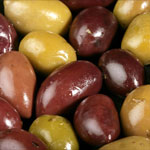 Olive oil is good for your health. Unfortunately, the production of olive oil is not. During the olive oil production process, olive oil mills produce a liquid waste called olive black water or olive-oil-mill wastewater (OMW). This waste water has significant polluting properties due to its high levels of chemical oxygen demand (COD), biochemical oxygen demand (BOD), and phenols. In Mediterranean countries, which account for approximately 95% of the worldwide olive oil production, the annual amount of OMW is estimated to be over 30 million cubic meters. Disposal of OMV has therefore always been an important issue in this region especially since conventional wastewater treatment methods are relatively ineffective for removing the kind of pollutants found in OMW. On the other hand, OMW may also be regarded as an inexpensive biomass source of inorganic and organic compounds. Using suitable separation processes, these compounds can be recovered and transformed into products for use in agriculture, environmental biotechnology processes, and industry. New research has now investigated the interaction of complexing dissolved organic matter with aluminum oxide nanoparticles.
Olive oil is good for your health. Unfortunately, the production of olive oil is not. During the olive oil production process, olive oil mills produce a liquid waste called olive black water or olive-oil-mill wastewater (OMW). This waste water has significant polluting properties due to its high levels of chemical oxygen demand (COD), biochemical oxygen demand (BOD), and phenols. In Mediterranean countries, which account for approximately 95% of the worldwide olive oil production, the annual amount of OMW is estimated to be over 30 million cubic meters. Disposal of OMV has therefore always been an important issue in this region especially since conventional wastewater treatment methods are relatively ineffective for removing the kind of pollutants found in OMW. On the other hand, OMW may also be regarded as an inexpensive biomass source of inorganic and organic compounds. Using suitable separation processes, these compounds can be recovered and transformed into products for use in agriculture, environmental biotechnology processes, and industry. New research has now investigated the interaction of complexing dissolved organic matter with aluminum oxide nanoparticles.
Jun 13th, 2008
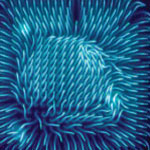 Light-emitting nanostructures are widely used for optical, photonic, chemical, and biological devices. For example, fluorescent nanoparticles are useful for biological assays and as tumor markers, chemical sensors, and organic lasers, whereas one-dimensional luminescent nanowires are exploited for novel nanoscale photonic devices such as nano-lasers and nanowire scanning microscopy. While several methods to prepare organic, inorganic, and polymeric light-emitting nanostructures have been developed, the fabrication of luminescent nanoarchitectures with a tailored morphology and pattern is still challenging. Researchers in Korea have discovered that non-luminescent polystyrene can be converted into a luminescent organic material whose emitting color can be tuned from deep blue to white by electron irradiation. They demonstrated that luminescent nanopatterns are readily fabricated only by irradiating an electron beam to the selected regions of polystyrene. In addition, the top-down irradiation approach in conjunction with self-assembled polystyrene nanostructures allows fabrication of diverse and complex luminescent nanoarchitectures.
Light-emitting nanostructures are widely used for optical, photonic, chemical, and biological devices. For example, fluorescent nanoparticles are useful for biological assays and as tumor markers, chemical sensors, and organic lasers, whereas one-dimensional luminescent nanowires are exploited for novel nanoscale photonic devices such as nano-lasers and nanowire scanning microscopy. While several methods to prepare organic, inorganic, and polymeric light-emitting nanostructures have been developed, the fabrication of luminescent nanoarchitectures with a tailored morphology and pattern is still challenging. Researchers in Korea have discovered that non-luminescent polystyrene can be converted into a luminescent organic material whose emitting color can be tuned from deep blue to white by electron irradiation. They demonstrated that luminescent nanopatterns are readily fabricated only by irradiating an electron beam to the selected regions of polystyrene. In addition, the top-down irradiation approach in conjunction with self-assembled polystyrene nanostructures allows fabrication of diverse and complex luminescent nanoarchitectures.
Jun 12th, 2008
 Nanomaterial-based drug-delivery and nanotoxicology are two of the areas that require sophisticated methods and techniques for characterizing, testing and imaging nanoparticulate matter inside the body. Especially the potential risk factors of certain nanomaterials have become a heated topic of discussion recently. Most, if not all, toxicological studies on nanoparticles rely on current methods, practices and terminology as gained and applied in the analysis of micro- and ultrafine particles and mineral fibers. The development of novel imaging techniques that can visualize local populations of nanoparticles at nanometer resolution within the structures of cells - without destroying or damaging the cell - are therefore important. Researchers in the U.S. have now demonstrated that at ultrasonic frequencies, intracellular nanomaterial cause sufficient wave scattering that a probe outside the cell can respond to. This ultrasonic holography technique provides a non-invasive way of looking inside a cell.
Nanomaterial-based drug-delivery and nanotoxicology are two of the areas that require sophisticated methods and techniques for characterizing, testing and imaging nanoparticulate matter inside the body. Especially the potential risk factors of certain nanomaterials have become a heated topic of discussion recently. Most, if not all, toxicological studies on nanoparticles rely on current methods, practices and terminology as gained and applied in the analysis of micro- and ultrafine particles and mineral fibers. The development of novel imaging techniques that can visualize local populations of nanoparticles at nanometer resolution within the structures of cells - without destroying or damaging the cell - are therefore important. Researchers in the U.S. have now demonstrated that at ultrasonic frequencies, intracellular nanomaterial cause sufficient wave scattering that a probe outside the cell can respond to. This ultrasonic holography technique provides a non-invasive way of looking inside a cell. 
 Subscribe to our Nanotechnology Spotlight feed
Subscribe to our Nanotechnology Spotlight feed





